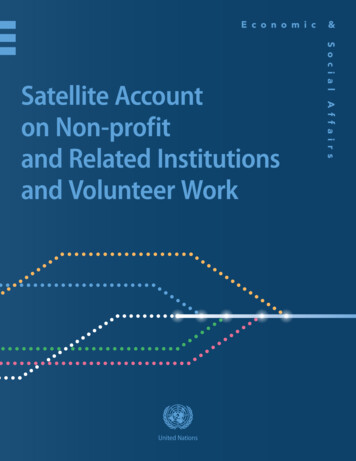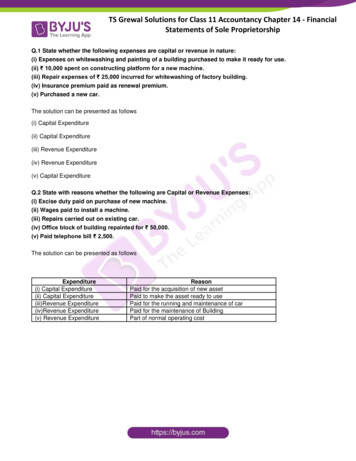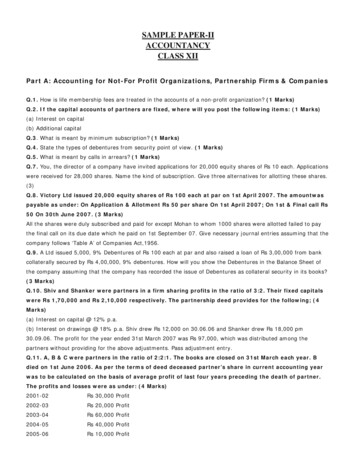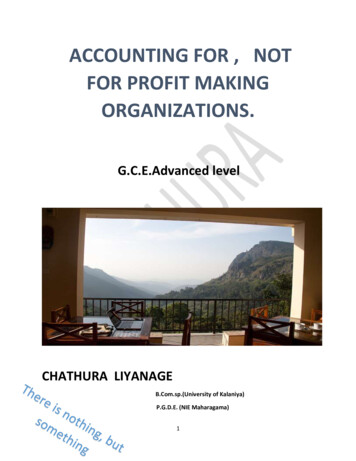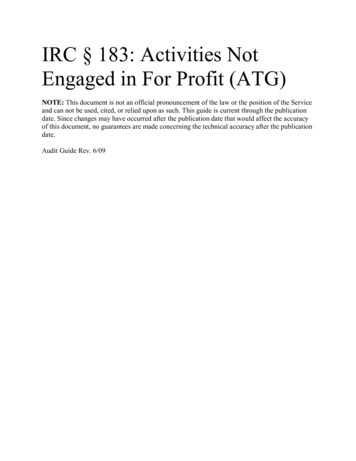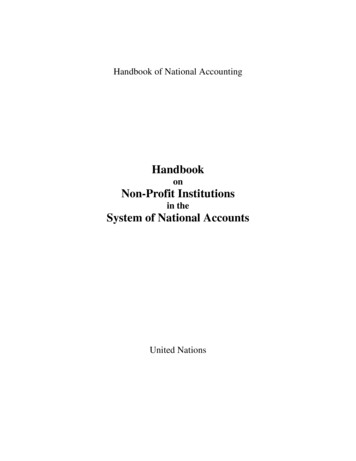
Transcription
Handbook of National AccountingHandbookonNon-Profit Institutionsin theSystem of National AccountsUnited Nations
ST/ESA/STAT/SER.F/91Department of Economic and Social AffairsStatistics DivisionStudies in MethodsSeries F., No. 91Handbook of National AccountingHandbook on Non-Profit Institutionsin the System of National AccountsUnited NationsNew York 2003
NOTESymbols of United Nations documents are composed of capital letters combined with figures.The designations employed and the presentation of the material in this publication do not implythe expression of any opinion whatsoever on the part of the Secretariat of the United Nations concerningthe legal status of any country, territory, city or area or of its authorities, or concerning the delimitation ofits frontiers or boundaries.Where the designation “country or area” appears, it covers countries, territories or areas.ST/ESA/STAT/SER.F/91UNITED NATIONS PUBLICATIONSales No: E.03.XVII.9ISBN 92-1-161461-9Copyright United Nations 2003All rights reservedPrinted in United Nations, New York
PrefaceThe Handbook on Non-Profit Institutions in the System of National Accountsrecommends statistical standards and guidelines for the development of data on nonprofit institutions (NPIs) within the System of National Accounts, 1993 (1993 SNA).The framework, concepts and classifications are designed as an extension andclarification of those underlying the 1993 SNA. The objective of developing NPI data isto improve and make available data on a sector that is growing in importance and that isoften ignored or little developed as part of the economy-wide compilation of data onnational accounts.The Handbook was prepared in close collaboration between the Johns HopkinsUniversity Center for Civil Society Studies and the Economic Statistics Branch of theUnited Nations Statistics Division. Particular mention may be made of the contributionsby Lester M. Salamon, Regina List, S. Wojciech Sokolowski and Helen Tice of the JohnsHopkins University Center for Civil Society Studies; Helmut K. Anheier, formerly at theJohns Hopkins University and now at the Centre for Civil Society, London School ofEconomics and Political Science, University of London; and Cristina Hannig, KárolyKovács, Jan W. van Tongeren, Vu Viet and Magdolna Csizmadia of the United NationsStatistics Division.Throughout the development of the Handbook, guidance was provided by aconsultative group, which met at United Nations Headquarters in New York on 13 and 14April 1999, 8 and 9 June 2000 and 8and 9 July 2001. Members of the consultative groupincluded (in alphabetical order): Heidi Arboleda (Economic and Social Commission forAsia and the Pacific); Édith Archambault (France); Estrella V. Domingo (Philippines);Lourdes Ferrán (Venezuela); Ezra Hadar (Israel); Anne Harrison (Organisation forEconomic Cooperation and Development (OECD)); Virginia Hodgkinson (UnitedStates); Youri Ivanov (Commonwealth of Independent States); Estelle James (WorldBank); Dickson Mzumara (Economic Commission for Africa (ECA)); Brian Newson,Statistical Office of the European Communities (Eurostat); Réné Rakotobe (ECA); LeenRoosendaal (Netherlands); and the late Richard Ruggles (United States). Advice wasoffered by Guy Standing and Azfar Khan of the In Focus Programme on Socio-EconomicSecurity, International Labour Organization.A draft of the Handbook was tested in 11 countries that varied in their level ofdevelopment.1 In many cases, the test built on current or previous work carried out inconnection with the Johns Hopkins Comparative Non-Profit Sector Project and membersof the network of local project associates often provided technical assistance to the1In addition, at an early stage in the development of the Handbook, a small group of United States expertswas convened to review a “worked example” based on United States administrative records data. Membersof that group included: Evelyn Brody (Chicago-Kent College of Law); Nadine Jalandoni (IndependentSector); Károly Kovács (United Nations Statistics Division); Linda Lampkin (National Center forCharitable Statistics); Wilson Levis (City University of New York); Charles McLean (Guidestar); Robert P.Parker (United States Bureau of Economic Analysis); Russy Sumariwalla (Consultant); and MurrayWeitzman (Consultant).iii
statistical offices carrying out the test. Teams carrying out the test met for orientation inThe Hague on 1 and 2 November 2000 and joined members of the consultative group atits July 2001 meeting in New York. Test countries and participants were: in Australia,David Bain and Sharon Bailey, Australian Bureau of Statistics; in Belgium, SybilleMertens, University of Liège, with the contribution of the national accounts departmentof the National Bank of Belgium; in Canada, Catherine Bertrand, Sophie Joyal, MalikaHamdad, James Chowhan, Karen Ashman and Kim Longtin, Statistics Canada; in Israel,Ezra Hadar, Nava Brenner, Aharon Blech and Soli Peleg, Central Bureau of Statistics; inItaly, Stefania Cuicchio, Raffaele Malizia, Andrea Mancini, Allesandro Messina andNereo Zamaro, Italian Institute of Statistics (ISTAT); in Mozambique, Saide Dade andAntonio Heber Lazo, Instituto Nacional de Estatistica and Jan van Tongeren, UnitedNations Statistics Division; in the Netherlands, Leen Roosendaal, P. R. H. van der Neutand W. van Nunspeet, Statistics Netherlands; in the Philippines, Estrella V. Domingo,National Statistical Coordination Board, and Ledivina Cariño, University of thePhilippines; in South Africa, Johan Prinsloo, Reserve Bank of South Africa, and Joe deBeer, Statistics South Africa; in Sweden, Ann-Marie Brathen, Torbjorn Israelsson,Christina Liwendahl and Birgitta Magnussson, Statistics Sweden and Filip Wijkstrom,Stockholm School of Economics; and in Thailand, Somjit Janyapong, SuchavadeeSrsuwannakan and Pak Tongsom, National Economic and Social Development Board.The United Nations Statistics Division also convened a meeting of SNA expertsto review the draft Handbook at United Nations Headquarters from10 to 12 July 2001.Members of the Expert Group included: Catherine Bertrand (Canada); Estrella V.Domingo (Philippines); Lourdes Ferrán (Venezuela); Ezra Hadar (Israel); OmarMohammad Ali Hakouz (Jordan); Anne Harrison (OECD); Clifford Lewis (Trinidad andTobago); Pablo Mandler (Argentina/Israel); Brian Newson (Eurostat); Réné Rakotobe(ECA); Kusmadi Saleh (Indonesia); and Kotb Salem (Egypt).Thanks to the involvement of the above-mentioned experts, advisers and testcountries, as well as additional meetings and deliberations held by the Center for CivilSociety Studies and the United Nations Statistics Division, it was possible to reflect in theconcepts, classifications and tables of the Handbook the theoretical and practicalexpertise of many national accountants and other specialists from a variety of developedand developing countries. The compilers of the Handbook wish to express their gratitudeto all of the advisers and experts who assisted in the development of therecommendations summarized here. As additional experience with the implementationof the present recommendations accumulates, updated recommendations may be issued.We are also grateful for the financial support of the Andrew W. MellonFoundation, the Ford Foundation, the Atlantic Philanthropies and the InternationalLabour Organization. Special thanks are also due to Paul Dekker of the Social andCultural Planning Office of the Netherlands for assistance in arranging the field testorientation meeting held in The Hague.iv
ContentsParagraphPreface .List of abbreviations and acronyms . PageiiiixChapter1.Introduction .1A.B.C.D.1.11.101.121361.191.2188E.2.Background .Why this Handbook? .Approach .The 1993 SNA as a platform for developing a globalinformation system on non-profit institutions Overview of the Handbook Defining NPIs . . 12A.B.C.D.E.F.121213141721Introduction Definition of NPIs in the 1993 SNA . .Sectoring of NPIs .Need for a satellite account on NPIs .NPI satellite account working definition Satellite account definition in practice 2.12.32.72.92.132.21BoxB2.1Working definition of the non-profit sector 18Treatment of non-profit institutions in the 1993 SNA Treatment of non-profit institutions in the NPI satellite account .1421Classifying NPIs .Introduction .The International Classification of Non-ProfitOrganizations (ICNPO) .(i)Main features of ICNPO .(ii) Modular approach (iii) Boundaries and other implementation issues v
Chapter3ParagraphPage(continued)C.Relation of ICNPO to the International StandardIndustrial Classification of All Economic Activities,Revision 3, and the Classification of the Purposes ofNon-Profit Institutions Serving Households . 3.28Suggestions for future development 3.323434ICNPO detailing of selected “catch-all” activity codes.ICNPO: groups and subgroups Correlation of ICNPO and ISIC, Rev.3 headings .Correlation of ICNPO and COPNI headings .29313639Key variables and tables of the NPI satellite account T3.2T3.3T3.44.C.D.E.Introduction .Key variables for the analysis of NPIs (i)Core monetary variables of the 1993 SNA .(ii) Additional monetary variables specific to NPIs.(iii) Core quantitative social and economic indicatorsof NPI structure, output and capacity .(iv) Additional quantitative and qualitativeextensions of the NPI satellite account .NPI satellite account tables (i)Overview .(ii) General structure of the NPI satellite accounttables .NPI satellite account process .Accounting treatment for new monetary variables .(i)Treatment of non-market services provided bymarket producers in the 1993 SNA .(ii) Treatment of imputed volunteer labour inputs formarket NPIs serving business .(iii) Treatment of imputed volunteer labour inputs fora non-market NPI FiguresF4.1Schematic representation of the NPI satellite account process .vi57
Chapter4Paragraph(continued)TablesT4.1T4.2Key variables and measures for NPIs Tables of the NPI satellite account in the full elaboration and in theshort form Production account of a market NPI, with sales less than total costs.Production account of a market NPI, with sales greater than totalcosts 61Implementing the NPI satellite account: data sources . 5.406869697071T4.3T4.45.C.6.PageOverview .Compilation of data on NPIs .(i)Building a NPI statistical register .(ii) Finding NPIs in existing data sources andcollection activities .(iii) Developing new data sources on NPIs .(iv) Integration of new and existing data sources onNPIs .Special Topics (i)Calculating the value of volunteer labour inputs.(ii) Capturing international flows of philanthropy .(iii) Capturing small and/or informal NPIs .435860Measuring NPI output 78818283836.286.316.338485856.3586Introduction .Physical indicators for specific fields .Group 1. Culture and recreation .Group 2. Education and research .Group 3. Health .Group 4. Social services .Group 5. Environment Group 6. Development and housing .Group 7. Law, advocacy and politics .Group 8. Philanthropic intermediaries and voluntarismpromotion Group 9. International Group 10. Religion . Group 11. Business and professional associations,unions .vii
AnnexesPageA1.International Classification of Non-Profit Organizations: detailed table .93A2.Tables of the NPI satellite account .98A3.A brief guide to the SNA for non-specialists .132A4.Glossary of SNA terms .146A5.Useful tools .184AppendicesA5(i)A5(ii)A5(iii)Johns Hopkins Comparative Non-Profit Sector Project: keyorganizational survey module Johns Hopkins Project: optional organizational surveymodule .Johns Hopkins Project: key population survey module on givingand volunteering orrelation of ICNPO and ANZSIC headings .Correlation of ICNPO and NACE-Bel headings Philippines: list of databases on non-profit institutions .Philippines: Securities and Exchange Commission data items .Philippines: Bureau of Internal Revenue data items .213215218222225Relation between the NPI satellite account and the 1993 SNA 227FigureAF6.1A7.Treatment of NPIs in the NPI satellite account .231Work in the non-profit sector: forms, patterns, methodologies (reproduction ofa report to the International Labour Organization, May 2001; separate table ofcontents provided) .238viii
LIST OF ABBREVIATIONS AND ACRONYMS1993 OVATSystem of National Accounts, 1993Australia and New Zealand Industry ClassificationCross-Classification by Industries and Institutional Sectors of ProductionAccount ItemsClassification of Environmental Protection ActivitiesCommonwealth of Independent StatesClassification of the Functions of GovernmentClassification of Individual Consumption According to PurposeClassification of the Purposes of Non-Profit Institutions Serving HouseholdsClassification of the Outlays of Producers According to PurposeCentral Product ClassificationDevelopment Assistance CommitteeEconomic Commission for AfricaEmployer identification numberEuropean System of AccountsEconomic and Social Commission for Asia and the PacificStatistical Office of the European Communitiesfull-time equivalent employmentInternational Classification of Activities for Time-Use StatisticsInternational Classification of Nonprofit Organizationsintegrated economic accountsInternational Labour OrganizationInternational Monetary FundUnited States Internal Revenue ServiceInternational Standard Classification of EducationInternational Standard Industrial Classification of All Economic Activitiesnot elsewhere classifiedGeneral Industrial Classification of Economic Activities within the EuropeanCommunitiesNorth American Industry Classification Systemnational income and product accountnon-profit institutionnon-profit institutions serving householdsOrganisation for Economic Cooperation and DevelopmentSystème de répertoire des entreprises et des établissementsSystem of National AccountsSocial Security NumberUnited Nations Educational, Scientific and Cultural Organizationvalue added taxix
CHAPTER 1IntroductionA. Background1.1The System of National Accounts, 1993 (1993 SNA) is a set of international guidelinesfor the development of economic accounts of member countries and for reporting such statisticsto international organizations in a manner comparable across countries.1 The 1993 SNAprovides an integrated framework of concepts, definitions, accounting rules, classifications andaccounts and tables—all designed to organize, in an analytically useful way, the transactions,other flows and stocks that make up the accounting record of the economy.1.2In order to maximize its usefulness, the guidelines and methodologies of SNA arenecessarily of a general nature. The universality of the SNA approach is one of its majoradvantages and indeed served as a guiding principle for its development and design. At the sametime, SNA guidelines suggest the expansion of SNA through the development of satelliteaccounts and more targeted handbooks in order to offer additional instructions and providespecific approaches and technical advice to national accountants, statisticians and other users ofnational accounts data on specialized topics (see 1993 SNA, Chap. XXI).1.3Such SNA satellite accounts are developed and used in order to shed further light on datafeatures needed for specialized analyses that are not contained or are not well represented in thecentral SNA framework but nonetheless reflect important economic, social and politicalconcerns.2 They expand the capacity and utility of SNA without overburdening and disruptingthe logical frame and integrity of the system as a whole. In such satellite accounts, amendmentsmay be made to concepts and the classification detail of the central SNA. More specifically, thehandbooks and satellite accounts generally extend SNA in three directions: first, they deal inmore detail with SNA concepts than is done in the SNA itself and in some cases adapt SNAconcepts to particular uses through satellite accounts; second, handbooks offer suggestions withregard to data sources and compilation approaches; and third, handbooks elaborate on the use ofdata in analysis.1.4Examples of guidelines on satellite accounts that have been published by the UnitedNations include the Integrated Economic Environmental Accounts3 and the Tourism SatelliteAccount.4 In addition, socio-economic satellite accounts are being developed.5 In the case ofenvironmental satellite accounts, amendments are made to the concept of intermediate1For a general overview, see Commission of the European Communities et al. (1993) and European Commission(1996); for discussion and background, see Keuning (1998); see also Carson (1996) and van Tongeren (1996).2Van Tongeren and Becker (1995).3United Nations (1993).4Commission of the European Communities, Organisation for Economic Cooperation and Development, UnitedNations and World Tourism Organization (2001).5For an example of socio-economic satellite accounts, see Republic of Korea, National Statistical Office andMinistry of Science and Technology, United Nations Development Programme and United Nations StatisticsDivision (2000).1
consumption in order to take into account environmental impacts on the cost of production. Inthe case of tourism satellite accounts, more detail is included in the breakdown of InternationalStandard Industrial Classification of All Economic Activities (ISIC) and Central ProductClassification (CPC) categories in order to identify tourism-related industries and products andto classify tourism expenditures in detail that serves the analysis of the tourism activities in acountry. Similarly, educational satellite accounts, as part of the socio-economic satelliteaccounts, may use a concept of human capital and, in accordance with that, define selectededucational expenses as capital formation instead of final consumption, as is the practicefollowed in the central framework of SNA.1.5The present Handbook is one in a series of handbooks dealing with various componentsof SNA. It completes the subset of handbooks issued by the United Nations dealing with SNAsectors. The series started with the Handbook on Household Sector Accounts6 and was followedby a handbook on the non-financial corporate sector and focused on the links between businessaccounting and national accounting concepts and practices.7 The other SNA sectors have beendealt with by International Monetary Fund (IMF) publications covering government financestatistics,8 money and banking statistics9 and balance of payments statistics.101.6The use of satellite accounts in the case of NPIs is needed because the central frameworkof SNA does not focus on an exhaustive identification of NPIs. To the extent that it focuses onNPIs, the SNA’s primary objective is to develop the criteria for the allocation of NPIs to theappropriate institutional sectors of SNA, i.e., government and financial and non-financialcorporations sectors. As to the remaining units serving the household sector, a separate sector—i.e., non-profit institutions serving households (NPISHs)—is created in order to bring out therevenues and final consumption expenditures of households, as distinct from those of NPISHs.Thus, SNA does not seek to develop a comprehensive picture of NPIs but rather focuses onallocating NPIs to other sectors based on certain characteristics that NPIs share with other unitsassigned to those sectors.1.7The present Handbook, however, is concerned with the identification of all NPIs in orderto permit better understanding of a sector of the economy that has been growing in manycountries but was not considered as important at the time the 1993 SNA was prepared. Theemphasis on NPIs in the present Handbook is reflected in three ways. One is the presentation ofa detailed definition of NPIs, which makes it possible to identify them as a group. Second is thevaluation of volunteer labour, which is significant in the activities of NPIs. Third is theintroduction of a detailed classification of NPIs by function. None of those elements is availablein the concepts and classifications of the central framework of the 1993 SNA.1.8The present Handbook thus seeks to provide additional guidance for coverage withinSNA of a set of institutions about which it is often difficult to gather data—namely, the wideassortment of institutions that operate in some sense separate from both the market and the state.It also seeks to organize the material on such organizations using a satellite account within the6United Nations (2000a).United Nations (2000b).8International Monetary Fund (2001).9International Monetary Fund (2000).10International Monetary Fund (1993).72
SNA structure so that it is more accessible to those with an interest in it. In the process, it helpsto clarify the composition of the sectors to which NPIs are assigned in the basic SNA byseparately identifying their NPI and non-NPI components.1.9The balance of the present chapter briefly describes the background of the Handbook,identifies the major needs it serves for different users and explains the rationale for the approachtaken in developing the Handbook. The introduction concludes with an overview of theHandbook’s structure and content by providing a brief summary of each chapter.B. Why this Handbook?1.10 The fundamental aim of the present Handbook is to respond to the growing interest thatstatisticians, policy makers and social scientists have in organizations that are neither marketfirms nor state agencies nor part of the household sector. Such social institutions are variouslyreferred to as “non-profit”, “voluntary”, “civil society” or “non-governmental” organizations andcollectively as the “third”, “voluntary”, “non-profit” or “independent” sector.11 Types oforganizations commonly included under these terms are sports and recreation clubs, art andcultural associations, private schools, research institutes, hospitals, charities, religiouscongregations and faith-based organizations, humanitarian assistance and relief organizations,advocacy groups and foundations and charitable trusts. Such non-profit institutions are currentlycovered by SNA; however, SNA does not group them into a single economic sector.1.11 Gaining a clearer overview of the broad NPI sector is increasingly important for a varietyof reasons:(a)NPIs constitute a significant and growing economic force in countries throughoutthe world. NPIs have recently come to be recognized as a major economic presence incountries throughout the world. Indeed, what one analyst has termed a “globalassociational revolution”,12 a massive upsurge of organized private voluntary activity,seems to be under way in many parts of the world at the present time as a product ofchanges in communications, new popular pressures and growing questioning of thecapabilities of government to solve pressing social and economic problems on its own.Indeed, recent research has demonstrated that non-profit organizations account for 8 to 12per cent of non-agricultural employment in many developed countries and even largershares of formal employment in many developing regions.13 Because much of therevenue supporting that sizeable non-profit sector comes from public sector payments inWestern Europe and from fees and charges in Japan, the United States and Australia, 14however, that set of institutions is allocated to the government and corporate sectors,respectively, in SNA and therefore largely disappears from view. The resources11In the present Handbook, the phrase “non-profit sector” refers to this set of organizations; as will be shown below,that usage is not equivalent to the SNA’s NPISHs; for a fuller treatment of the definition and classification of nonprofit organizations, see Salamon and Anheier (1997).12Salamon (1994).13Salamon et al. (1999); and Anheier and Ben-Ner (1987).14Salamon et al. (1999).3
controlled by institutions identified as NPISHs in SNA thus turn out to represent only asmall portion of all the resources controlled by non-profit institutions in most countries;15(b)NPIs have distinct features that justify treating them as a separate sector for manyanalytical purposes. The placement of the economically most important NPIs into thecorporate or government sectors not only obscures the size of the NPI sector but alsocomplicates the picture that is provided of the corporate and government sectors. Giventhe distinctive features of NPIs, a case can be made for splitting them out from the otherentities in those sectors, at least for some analytical purposes. Among the distinctivefeatures of NPIs that justify such special identification are the following:(i)Not-for-profit character. Although they may earn profits, NPIs are not organizedfor profit and cannot distribute any profits earned to their directors or managers.They therefore have different objective functions from the for-profit firms withwhich some of them are grouped. Non-profit entrepreneurs are often driven bysocial or ideological impulses, not primarily pecuniary ones;(ii)Public-goods production. Although they often produce private goods that are soldon the market, NPIs also typically produce collective goods that are financedthrough other means (e.g., charitable contributions, volunteer effort). NPIs oftenarise where “free rider” problems impede the emergence of market producers yetwhere lack of sufficient political support also keeps government from becominginvolved;(iii)Governance structures. The governance structures of NPIs differ from those ofboth corporations and governmental units. Non-profit boards are not publiclyelected and are rarely paid. Non-profits are therefore different types of units tomanage;(iv)Revenue structure. The sources of non-profit revenue also differ from those ofgovernment and for-profit firms. In particular, they include important voluntarydonations of time and money that are not available to for-profit producers and thatare also far less extensively utilized by government agencies, which in turnrequires different revenue-raising strategies and different orientations to themarket;(v)Staffing. The staffing of non-profit organizations is also different, often includingsubstantial numbers of volunteers;(vi)Capital sources. Since they cannot distribute profits, NPIs cannot attract equitycapital. As a result, the composition of their payments of property income differfrom those of for-profit enterprises;(vii)Tax treatment. NPIs are typically exempt from corporate income taxes, and mayalso be exempt from other taxes, such as sales taxes and property taxes. In15This is not just a theoretical possibility; Archambault (1998) finds that the application of the SNA sectoringscheme results in an NPISH that substantially understates the French non-profit sector.4
addition, they are often exempt from provisions that apply to for-profitcorporations;(viii) Legal treatment. NPIs are often subject to special legal provisions relating to thecomposition of their boards, their purposes, their revenues, their involvement inpolitical activities, the compensation of their staff, and their reporting andaccounting standards. In addition, they are often exempt from provisions thatapply to for-profit corporations;(ix)Lack of sovereign powers. Although they often receive government financialsupport, NPIs lack the defining feature of a governmental entity, i.e., “compulsorypowers over all those dwelling or carrying on activities within a given area”;16(x)Relative detachment from political pressures. NPIs operate with considerablymore detachment from political pressures than regular units of government.Indeed, that is one of the reasons acknowledged by the 1993 SNA (see para. 4.62)for Governments to rely on NPIs for certain functions rather than carrying out thefunctions themselves;(xi)Characteristic types of transactions. NPIs have two characteristic transactionsthat cannot be accommodated in the corporations sectors of SNA: they have finalconsumption expenditure and they receive transfer payments in the form ofphilanthropic donations;(c)NPIs are increasingly a focus of concern in public policy. A third reason for separatingNPIs out and focusing attention on them is that those institutions have recently attractedincreased attention from policy makers, who have been searching for ways to improve thequality of public services and reduce the size of the state. Because of their distinctivefeatures as private institutions serving public purposes, non-profit organizations offerimportant advantages in that regard. Indeed, major initiatives have recently beenlaunched in the United States, the United Kingdom, France, Italy, Canada, theNetherla
The Handbook on Non-Profit Institutions in the System of National Accounts recommends statistical standards and guidelines for the development of data on non-profit institutions (NPIs) within the System of National Accounts, 1993 (1993 SNA). The framework, conc
